| Property 1 |
The rows and columns of determinants have equal rights, that is,
![]() .
.
Proof: The property follows from
the definition of determinants. Really, ![]() is the sum of the same terms as
is the sum of the same terms as ![]() . The only difference between them
is the order of the terms that does not influence the value of the sum.
. The only difference between them
is the order of the terms that does not influence the value of the sum.
| Property 2 |
Multiplying any row or column of a determinant by a number ![]() , multiplies the determinant by that
number:
, multiplies the determinant by that
number:

This means that the common factor of a row (or column) can be taken outside the sign of a determinant.
Proof: Every term of the sum

contains one and only one element of a given row or column of the determinant. If the row (or column) is multiplied by a number, each the term is multiplied by that number.
| Property 3 |
Interchanging any two rows (or columns) of a matrix changes the sign of the determinant:
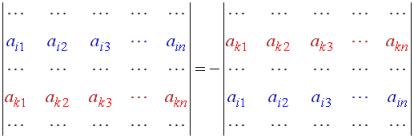
Proof: By Theorem 1, any transposition changes the inversion parity of a given permutation. Therefore, each term of the sum

changes its sign.
| Property 4 |
If a determinant has a zero-row or zero-column then the determinant is equal to zero:
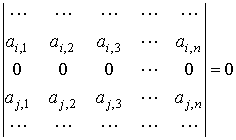
Proof: Every product of the sum

contains a zero factor and so equals zero.
| Property 5 |
If a determinant has two rows (or columns) equal then the determinant is equal to zero:
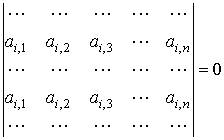
Proof: If the two identical rows (or columns) are interchanged, then by Property 3 the determinant changes its sign. On the other hand, the rows (or columns) are equal and so the determinant must keep its value:
![]()
![]()
![]()
| Property 6 |
If two rows (or columns) of a determinant are proportional to each other then the determinant is equal to zero:
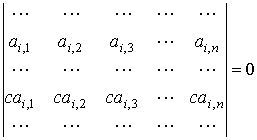
Proof: Multiplying the i-th row of the determinant by the constant of proportionality we obtain the determinant with equal rows.
| Property 7 |
If each element of a row (or column) of a determinant is the sum of two items then
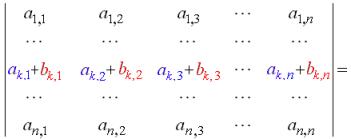
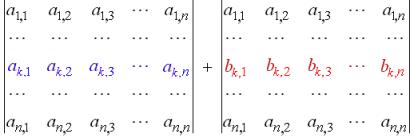
Proof:
![]()
| Property 8 |
A determinant holds its value if a row (column) multiplied by a number is added to another one:

Proof: The determinant on the right side hand can be represented as the sum of two determinant, one of which contains two rows proportional and so equals zero.
| Property 10 |
The determinant of a triangular matrix is equal to the product of the diagonal elements:
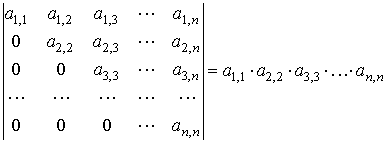
In particular, the determinant of an identity matrix is equal to unity.
Proof: There is only a single non-zero element a1,1 on the first column. Then we have to ignore the first row and chose a non-zero element on the second column that is a2,2. Likewise, on the third column we can take only the element a3,3to get a non-zero product of elements, and so on. Therefore, all appropriate permutations of indexes give a zero yield to the determinant except the product of the diagonal elements.